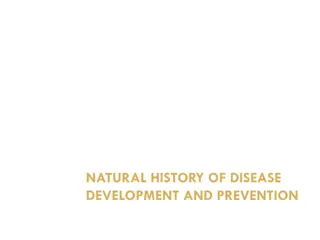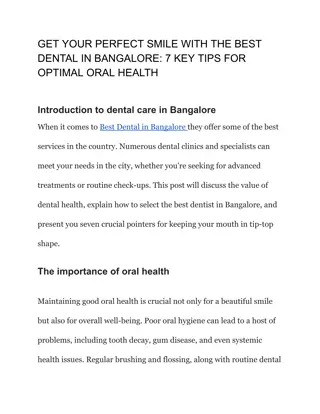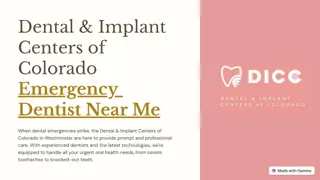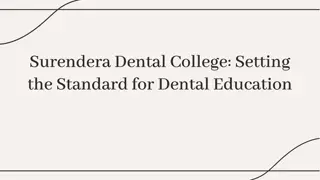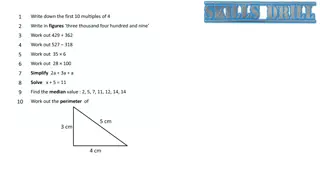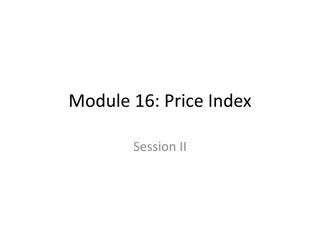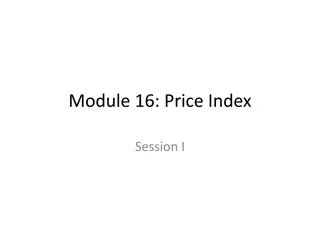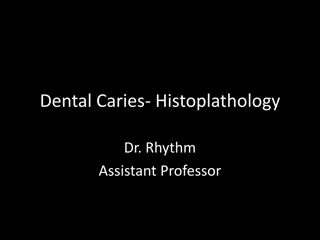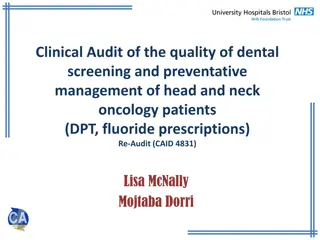Dental Indices: Tools for Disease Assessment and Prevention
Dental indices are essential devices used to assess the incidence, prevalence, and severity of oral diseases, guiding the adoption of preventive programs. The ideal index should possess characteristics such as objectivity, reliability, sensitivity, and acceptability to both examiners and patients. Criteria for selecting an index include simplicity, reproducibility, cost-effectiveness, patient comfort, and ease of use. Indices can be classified based on score fluctuation direction and the extent of oral cavity areas measured, providing valuable insights for effective dental care strategies.
Download Presentation

Please find below an Image/Link to download the presentation.
The content on the website is provided AS IS for your information and personal use only. It may not be sold, licensed, or shared on other websites without obtaining consent from the author.If you encounter any issues during the download, it is possible that the publisher has removed the file from their server.
You are allowed to download the files provided on this website for personal or commercial use, subject to the condition that they are used lawfully. All files are the property of their respective owners.
The content on the website is provided AS IS for your information and personal use only. It may not be sold, licensed, or shared on other websites without obtaining consent from the author.
E N D
Presentation Transcript
INTRODUCTION Dental index or indices are devices to find out the incidence, prevalence and severity of the disease ,based on which preventive programs can be adopted.
INDEX A numerical value describing the relative status of a population on a graduated scale with definite upper and lower limits, which is designed to permit and facilitate comparison with other populations classified by the same criteria and methods. - Rusell A.L
IDEAL REQUIREMENTS OF AN INDEX Clarity, simplicity and objectivity The examiner should able to remember the criteria easily. It should be easy to apply and criteria should be clear. Validity The index must measure what is intent to measure.
Reliability The index should measure consistently at different time and various conditions. Sensitivity The index should b able to detect reasonably small shifts, in either direction in the group condition.
Acceptability The use of index should not be painful or embarrassing to the subject. Quantifiablity: The index should be amenable to statistical analysis.
CRITERIA FOR SELECTING AN INDEX 1. Simple to use and calculate. 2. Should permit the examination of many people in a short period of time. 3. Should require minimum armamentarium and expenditure. 4. Should be highly reproducible in assessing a clinical condition when used by one or more examiners. 5. Should not cause discomfort to the patient and should be acceptable to the patient.
CLASSIFICATION OF INDICES i. Based upon the direction in which their scores can fluctuate. o Irreversible index : Irreversible index : measures conditions whose scores will not decrease on subsequent examinations. Eg: DMFT index o Reversible index: Reversible index: measures conditions that can increase or decrease on subsequent examinations. Eg: Loe and Silness gingival index.
ii. Depending upon the extent to which areas of oral cavity are measured. o Full mouth indices : Full mouth indices : measures the patient s entire periodontium or dentition. Eg : Russell s periodontal index (PI) o Simplified indices : Simplified indices : measures only a representive sample of the dental apparatus. E.g. : Oral hygiene index simplified(OHI-S).
iii. Based upon entity which they measure o Disease index: Disease index: D (decay) portion of the DMFT index. o Symptom index: Symptom index: measuring gingival / sulcular bleeding. o Treatment index: Treatment index: F (filled) portion of DMFT index .
iv. Special categories o Simple index : Simple index : measures presence or absence of a condition. Eg Silness and Loe Plaque index Cumulative index : Cumulative index : measures all evidences of a condition past and present. Eg DMFT index for dental caries. o
USES FOR INDIVIDUALS FOR INDIVIDUALS Provide individual assessment to help patient recognize an oral problem. Reveal degree of effectiveness of present oral hygiene practices. Motivate the person in preventive and professional care for elimination and control of oral disease. Evaluate the success of individual & professional treatment over a period of time by comparing index scores.
In research: In research: Measure effectiveness of specific agents or devices for prevention/control/treatment of oral conditions.
In community health In community health Show prevalence and trends of incidences of a condition occurring within a population. Assess needs of a community.
Dental plaque Dental plaque: is a complex, metabolically interconnected , highly organized , bacterial ecosystem. It is a structure of vital significance as a contributing factor to the initiation of the carious lesion. Dental calculus Dental calculus : is a hard deposit that forms by mineralization of dental plaque & is usually covered by a layer of unmineralized plaque.
ORAL HYGIENE INDEX(OHI) SIMPLIFIED ORAL HYGIENE INDEX(OHI-S) 3. PLAQUE INDEX(PI) 4. GINGIVAL INDEX(GI) RUSSELL S PERIODONTAL INDEX(PI) COMMUNITY PERIODONTAL INDEX OF TREATMENT NEEDS (CPITN) 7. DECAYED-MISSING-FILLED TEETH INDEX(DMFT) 8. DEAN S FLUOROSIS INDEX 1. 2. 5. 6.
o Developed in 1960 by John C Greene & Jack R vermillion. o To classify and assess oral hygiene status. o OHI comprises of 2 components DEBRIS INDEX(DI) DEBRIS INDEX(DI) CALCULUS INDEX(CI) CALCULUS INDEX(CI)
Each segment examined for debris or calculus. From each segment one tooth is used for calculating the individual index for that segment. The tooth used for the calculation must have the greatest area covered by either debris or calculus. Buccal/labial and lingual surfaces. DI no:23 explorer (shepherd s hook) CI no:5 explorer
Criteria and scoring DEBRIS DEBRIS Scores Scores Criteria Criteria 0 No debris or stain present 1 Soft debris covering not more than one third of the tooth surface, or presence of extrinsic stains without other debris regardless of surface area covered 2 Soft debris covering more than one third, but not more than two thirds, of the exposed tooth surface. 3 Soft debris covering more than two thirds of the exposed tooth surface.
CALCUS SCORE Scores Scores Criteria Criteria 0 No calculus present 1 Supragingival calculus covering not more than one third of the exposed tooth surface. 2 Supragingival calculus covering more than one third but not more than two thirds of the exposed tooth surface or the presence of individual flecks of subgingival calculus around the cervical portion of the tooth or both. 3 Supragingival calculus covering more than two third of the exposed tooth surface or a continuos heavy band of subgingival calculus around the cervical portion of the tooth or both.
Calculation DI = buccal total score + lingual total score no: of segments CI = buccal total score + lingual total score no: of segments OHI = DI+CI DI & CI = 1-6 OHI = 0-12 Higher the score poorer the oral hygiene.
1964,John C Greene & Jack R vermillion. No : of tooth surfaces scored is 6 rather than 12. Criteria and scoring same as OHI.
Surfaces and teeth to be examined Surfaces and teeth to be examined
Substitution : 16 -17 17 - 18 11 21 etc Natural teeth with full crown restorations and surfaces reduced in height by trauma/caries not scored. Instruments: Mouth mirror,no:23 explorer(shepherd s hook)
Criteria & scoring Debris index-simplified DEBRIS DEBRIS Scores Scores Criteria Criteria 0 No debris or stain present 1 Soft debris covering not more than one third of the tooth surface, or presence of extrinsic stains without other debris regardless of surface area covered 2 Soft debris covering more than one third, but not more than two thirds, of the exposed tooth surface. 3 Soft debris covering more than two thirds of the exposed tooth surface.
Calculus index- simplified Scores Scores Criteria Criteria 0 No calculus present 1 Supragingival calculus covering not more than third of the exposed tooth surface. 2 Supragingival calculus covering more than one third but not more than two thirds of the exposed tooth surface or the presence of individual flecks of subgingival calculus around the cervical portion of the tooth or both. 3 Supragingival calculus covering more than two third of the exposed tooth surface or a continuos heavy band of subgingival calculus around the cervical portion of the tooth or both.
Calculation DI-S = Total score No : of surfaces examined CI-S = Total score No : of surfaces examined OHI-S = DI-S + CI-S
Interpretation For DI-S & CI-S score, Good Fair Poor 0.0 0.6 0.7 1.8 1.9 3.0 For OHI-S Good Fair Poor 0.0 1.2 1.3 3.0 3.1 6.0 Study of epidemiology of periodontal diseases.
3.PLAQUE INDEX(PII 3.PLAQUE INDEX(PII) Described by Silness P and Loe H in 1964. This index measures the thickness of plaque on the gingival one third. Used as full mouth index/simplified index. INDEX TEETH INDEX TEETH:16,12,24,36,32,44 No substitution if any one of the above teeth are missing. Areas examined Areas examined: : distofacial, facial,mesio-facial and lingual surface of tooth. Instruments: : mouth mirror,dental explorer. Instruments
Criteria & scoring Score Score Criteria Criteria 0 No plaque 1 A film of plaque adhering to the free gingival margin and adjacent area of the tooth, which can not be seen with the naked eye. But only by using disclosing solution or by using probe. 2 Moderate accumulation of deposits within the gingival pocket, on the gingival margin and/ or adjacent tooth surface, which can be seen with the naked eye. 3 Abundance of soft matter within the gingival pocket and/or on the tooth and gingival margin.
Calculation Calculation PII for a tooth PII for a tooth = Scores of 4 areas 4 PII for individual PII for individual = total scores no: of teeth examined PII for group PII for group = total score no: of individuals Interpretation Interpretation Excellent Excellent Good Good Fair Fair Poor Poor 0 0 0.1 0.1- -0.9 1.0 1.0- -1.9 2.0 2.0- -3.0 0.9 1.9 3.0
Developed by Loe H and Silness P in 1963. For assessing severity of gingivitis. Instrument: mouth mirror , periodontal probe.
Index teeth Tissues surrounding each tooth divided into 4 gingival scoring units. i. DISTO-FACIAL PAPILLA ii. FACIAL MARGIN iii. MESIO-FACIAL PAPILLA iv. LINGUAL GINGIVAL MARGIN.
Scoring criteria SCORE SCORE CRITERIA CRITERIA 0 Absence of inflammation/normal gingiva. 1 Mild inflammation, slight change in color, slight edema, no bleeding on probing. 2 Moderate inlammation,moderate glazing, redness, edema and hypertrophy, bleeding on probing. 3 Severe inflammation, marked redness and hypertrophy , ulceration, tendency to spontaneous bleeding.
Calculations 1. 4 2. GI score individual = Sum of indices of teeth no: of teeth examined 3. GI score for group = Sum of all members total no:of individuals 1.1-2.0 Moderate gingivitis GI score for a tooth = Scores from 4 areas Interpretation Condition Condition Gingival Gingival scores scores 0.1-1.0 Mild gingivitis 2.1-3.0 Severe gingivitis
5.Russells periodontal index(PI) 5.Russell s periodontal index(PI) Developed by Russell A.L in 1956 To estimate deeper periodontal diseases. All teeth present examined. Gingival tissue surrounding each tooth assessed for gingival inflammation and periodontal involvement. Instruments Instruments : mouth mirror, plain probe.
Scoring criteria Score Score Criteria Criteria Additional radiographic Additional radiographic features features 0 NEGATIVE, neither overt inflammation in investing tissues nor loss of function due to destruction of supporting tissue. Radiographic features normal 1 MILD GINGIVITIS , overt area of inflammation in free gingiva. 2 GINGIVITIS: inflammation completely circumscribes tooth but no break in epithelial attachment. 4 Used only when radiographs are available. Early notch like resorption of alveolar crest. 6 GINGIVITIS WITH POCKET FORMATION. Horizontal bone loss involving alveolar crest up to half length of root. 8 ADVANCED DESTRUCTION WITH LOSS OF MASTICATORY FUNCTION. Advanced bone loss.
Calculation PI score per person = Sum of individual scores No: of teeth present Interpretation Clinical condition Clinical condition Clinically normal supportive tissues Individual PI score Individual PI score 0-0.2 Simple gingivtis Beginning destructive periodontal disease 0.3-0.9 1.0-1.9 Established destructive periodontal disease 2.0 -4.9 Terminal disease 5-8
6.Community periodontal index of 6.Community periodontal index of treatment needs(CPITN) treatment needs(CPITN) Developed by joint committee of WHO & FDI in 1982. To survey and evaluate periodontal treatment needs. Advantages Advantages: Simplicity Speed International uniformity.
PROCEDURE: PROCEDURE: Dentition divided into sextants. Each sextant given a score. 17 17- -14 14 13 13- -23 23 24 24- -27 27 47 47- -44 44 43 43- -33 33 34 34- -37 37 INSTRUMENTS: INSTRUMENTS: CPITN PROBE
CPITN probe WHO periodontal examination probe. Used for Measurement of pocket depth & Detection of subgingival calculus. Weight = 5gms 2 types: a. a. CPITN CPITN- -E(epidemiological probe) E(epidemiological probe) - Pocket depth measured through color coding; black mark starting from 3.5mm - 5.5mm - Ball tip diameter 0.5mm; easy detection of sub gingival calculus
b) CPITN-C ( clinical probe) of deep pockets. Variant probe basic probe 2 additional markings 8.5mm & 11.5 mm Detailed assessment & recording
Index teeth Best estimators of the worst periodontal condition of the mouth. >20 years 17/16 17/16 47/46 47/46 11 11 31 31 26/27 26/27 36/37 36/37 Molars examined in pairs & highest score recorded. Up to 19 years 16 16 46 46 11 11 31 31 26 26 36 36
Coding criteria Code Code CODE X Only one tooth or no teeth present in a sextant. CODE 4 Pathological pocket of 6mm or more present. CODE 3 Pathological pocket of 4mm-5mm present. CODE 2 Presence of supra or sub gingival calculus. CODE 1 Gingival bleeding after gentle probing CODE 0 No signs of disease. Criteria Criteria
Classification of treatment needs TN0 Code 0(healthy) or code x (missing) for all sextants indicates no treatment required. TN1 Code 1 need to improve oral hygiene. TN2a Code 2 need for scaling, improve personal oral hygiene. TN2b Code 3 need for scaling ,root planing,improve oral hygiene. TN3 Code 4 needs deep scaling , root planing & complex surgical procedures.
7.DECAYED 7.DECAYED- -MISSING TEETH INDEX (DMFT) TEETH INDEX (DMFT) Developed by Henry T Klein,Carrole E. Palmer and Knutson J W in 1938. To determine prevalence of coronal caries. Advantages: Advantages: Simple Rapid Versatile Universally accepted MISSING- -FILLED FILLED




